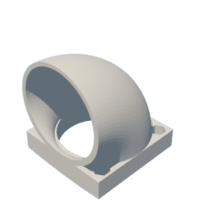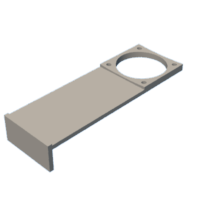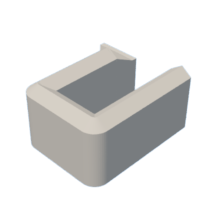Introduction: Halloween Fog Helper
Halloween fog looks great until the dry ice starts running low or the water cools off. Without spooky fog rolling over the edge of a cauldron it just becomes a pot full of white fluff. No one wants that!
Want to make your Halloween fog easier and better? Read on...
In practice, a large amount of dry ice is added to very hot water to get a vigorously 'boiling' cauldron with lots of fog flowing over the edge. It looks so creepy! But soon the water cools or the dry ice evaporates and you have just wisps of fog flowing over the edge. Having to keep feeding dry ice and hot water to a display can be annoying. This can be particularly challenging for large containers that you want filled with fog.
So, what if you could make your dry ice last longer and still have good looking fog? Or get the best performance out of an ultrasonic atomizer (pond fogger)?
This is where the Halloween Fog Helper comes in. The Fog Helper injects air into the container to help push the fog out and over the edge, giving that spooky look we want. Injecting air into your container means that you don't have to use as much dry ice since it's not the CO2 gas coming off the dry ice that has to push fog out of the cauldron.
I wanted the Fog Helper to be portable and not be tied to an outlet so the fan used in the Fog Helper is USB powered (5Vdc). The Helper uses a portable USB power bank (battery pack) for power. Of course you could also use a plug-in-the-wall USB power adapter.
In the following steps you'll see how to make your own Halloween Fog Helper!
Don't have stagnant fog!.... Use a Halloween Fog Helper!
P.S. You might be interested in some of my other Halloween related instructables in this collection.
If you find the Instructables I post interesting please click the "Follow" button above. Thanks!
Supplies
- 3D printed parts (I've attached the .stl files)
- 1 - Small USB fan with integral USB cable, OR build your own with:
- Small 5VDC Computer Fan (I used 40mm x 40 mm x 10mm)
- USB cable & solder and heat shrink tubing
- 1 - USB power bank or other USB power source
- 4 - 3mm dia (M3) stainless steel machine screws and nuts
- Hot Glue Gun and sticks
- Fog containers (I used18 gallon drink ice bucket; 12-inch opening plastic cauldron)
- Rubber band
- 1 - Banana for scale (not required)
Step 1: Two Versions: Through-wall & Over-the-top
Depending on the application either a Through-Wall or Over-the-Top version of the Fog Helper can be used. Both provide injection of air into the fog cauldron (or other container) to push fog out.
The Through-Wall version is great for plastic containers, while the Over-The-Top version is great when you don't want to cut a hole in the container; for example if you have a metal or ceramic cauldron or the cauldron has special sentimental value.
Step 2: Design Through-wall Version
I used Fusion 360 to design the through-wall parts.
I wanted to inject air with the air flow pointing downward. To do this it seemed logical to just have a 90° elbow inside the container to direct the flow downward. On the outside I wanted a simple block to mount the fan on and had the idea to have a bracket extend down from the fan that provides a shelf to support a USB power bank. The power bank gets held in place with a rubber band.
The pipe looking thing (elbow) goes inside the fog container and the long rectangular thing (bracket) goes on the outside.
The two 3D printed pieces attach to each other with the container sandwiched between them. They are held together with 3mm diameter (M3) machine screws and nuts. There are hex-shaped recesses in the internal 'pipe section' to hold the nuts.
I always keep learning new things in Fusion 360. For the 90 degree pipe-looking thing I used the "Pipe" tool that has a circular or square extrusion follow a path you sketch. I used it to create the 'pipe' angling the air 90° downward. In the images above you can see the blue path line I sketched for the pipe tool to follow.
The surface of the 3D printed interior and exterior pieces that touch the wall of the container match the radius of the container in order to provide a good seal. The radius of the 18 gallon plastic bucket at the height where the Fog Helper is mounted is 9 inches. So the 3D model curves the mating surfaces taking into account the 9 inch radius.
Step 3: 3D Print Through-wall Version
I printed in PLA with a brim on the pipe piece. I was pushing the size limit of my build plate on the outside bracket so I could not add a brim.
There are no supports on either of these pieces since you can usually print a circular opening in a vertical surface without too much problem.
Both pieces need to be 3D printed in the orientation shown as they have subtle curves on the surface with the 4 mounting holes (That surface matches the curve of the wall of the container) and that slightly curved surface can't lay flat on a build plate.
Step 4: Install Through-wall Version
Select a location that is far enough below the lip of your container to conceal the Halloween Fog Helper in fog, but not so low that you are in danger of getting water into the Helper.
I drilled a 1-3/8 inch diameter hole (which is just slightly smaller than the internal diameter of the fan opening) through the wall of the container for the passage of air.
I drilled four mounting holes through the container corresponding to the fan mounting holes. You can use a fan assembly with the integral USB cable, or make one as outlined in Step 8.
Load hex nuts into the recesses in the 'pipe thing'. Line up the four parts: the fan, the outside bracket, the wall of the container and the interior 'pipe thing' then thread M3 machine screws through all four parts and tighten the screws.
The USB power bank sits on the shelf and is held in place by a rubber band. Just plug in the USB cable into the power bank when you want the Fog Helper to operate.
Step 5: Through-Wall Dry Ice Results
I put a gallon of hot (110°F) water in a smaller bowl inside this 18 gallon container and added 1 pound of dry ice. The Halloween Fog Helper was mounted through the wall.
There are two sets of two photos; each with the first showing the Fog Helper operating, and the second photo with the Fog Helper off and the dry ice just not doing much. The photos were taken a couple of minutes apart.
Don't mind the banana it's just to provide an idea of the scale.
Step 6: Design Over-the-top Version
For the over-the-top version I just wanted an inverted "U" to sit over the edge of the container in order to keep it simple.
I also didn't want any supports when I 3D printed it so I had to consider how I could do that. It would be really hard to get into the internal space at the top of the inverted "U" (can I say near impossible?) to clear out supports.
I also used Fusion 360 to design this part and learned a new tool, "Sweep", which allows a shape to be electronically 'extruded' while following a line showing the path to follow.
I created the profile (cross-section) of the air path tube and then used "Sweep" to have it 'extrude' the shape along a path I had sketched out. This worked really well! I was amazed.
In the design I made sure that areas where I would want horizontal surfaces with nothing under them (Can't print on air) I just inclined them so that when it came to 3D printing I would not need supports.
After 'extruding', the air path tube looks like the wing of some prestigious university with a peaked roof (with no internal supports). I went on to add an integral flared 'adapter' to connect the computer fan and match its shape to the air tube.
Step 7: 3D Print Over-the-top Version
Print the over-the-top version. Again no room for a brim and no supports due to the angled 'roof' design.
Note that this was my first pass at this design. I now realize that the fan mounting holes do not have enough room for a nut behind them. Oops!..... I could redesign, but instead I just decided to hot glued the fan to the the 3D print when it came time to mount the fan.
Step 8: Build Fan Assembly
The Halloween Fog Helper needs a fan to push the air. You can use a preassembled USB fan assembly that consists of the fan with an integral USB cable OR you can build one by taking a USB fan and soldering on a USB cable.
I had some dysfunctional USB charging cables that went bad at the phone end of the cable, so I cut the bad end off and soldered on the USB fan. I used heat shrink tubing over the splice to electrically insulate it.
I lined up the fan with the 3D print and apply hot glue to the corners of the print. Press the fan into the glue minding that the fan cable exits in a direction that will not hit the cauldron. After the glue has cooled you can run a bead of glue around the perimeter of the joint to make it airtight.
Step 9: Install Over-the-top Version
Just hang the Over-The-Top version over the lip of the cauldron or other fog container, plug the USB cable into the USB power bank or other USB power source and away you go. Non-stagnant flowing fog!
Step 10: Over-the-top Dry Ice Results
For this smaller container (it's still a very large plastic cauldron; 12 inch opening) I added a half-gallon of hot water (110°F) to the plastic cauldron and added half pound of dry ice.
Again, the photos are in two sets of two photos with the first in the set showing the Halloween Fog Helper in place and operating and the second photo in the set with the Fog Helper disconnected (actually not even hanging on the cauldron in the 1st no Helper photo; and acting as a syphon for heavy CO2 gas in the 2nd no Helper photo). Both photos were taken a couple of minutes apart.
Again, the banana is just to give an element of scale.
Step 11: Ultrasonic Fog & Halloween Fog Helper
When using dry ice the CO2 gas given off from the dry ice propels the fog (water droplets) over the edge and out of the cauldron. But with ultrasonic atomizer fog makers there is no gas released to push the fog over the edge of the cauldron. This is where the Halloween Fog Helper really shines.
Ultrasonic atomizer fog makers (pond foggers), which create fog by rapidly vibrating the surface of the water, really need the Halloween Fog Helper! Without the Helper ultrasonic atomizer created fog just pools in the cauldron and won't budge, unless moved by a breeze. The Halloween Fog Helper fan pushes air into the cauldron and forces the fog up and out of the cauldron.
For large containers there is really only one way to go -- Use a large ultrasonic atomizer (pond fogger) along with a Halloween Fog Helper!
So nice to NOT need to feed dry ice and hot water to a cauldron!
Now go enjoy making some really great fog (dry ice or ultrasonic)!
I incorporated the same concept of injecting air into a full-size cauldron that used an ultrasonic atomizer over 10 years ago. I'm sold on the concept!

Participated in the
Halloween Contest
















